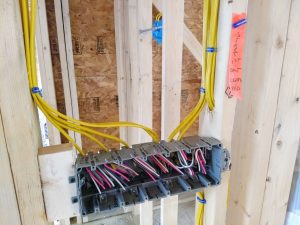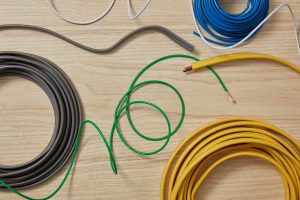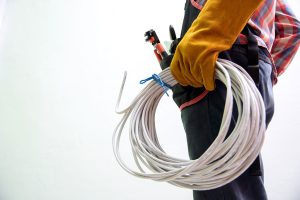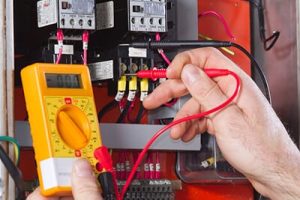The History and Evolution of Electrical Wiring
June 20, 2024Electrical wiring is the backbone of modern homes, providing the essential framework for our power needs. The evolution of residential electrical wiring reflects not only advancements in technology but also the changing needs and safety standards of homeowners. From humble beginnings to complex modern systems, the history of electrical wiring is a fascinating journey through innovation and adaptation.
Early electrical wiring methods were rudimentary, often consisting of simple conductors wrapped in insulating material. These methods evolved as electricity became more prevalent, leading to the development of safer and more efficient wiring practices. Today, residential electrical wiring incorporates a variety of materials and techniques designed to meet the demands of modern living while adhering to stringent safety standards. This article explores the history, innovations, and future trends of residential electrical wiring, shedding light on this essential aspect of modern life.
Early Methods of Electrical Wiring in Homes
In the early days of residential electrical wiring, homes were often wired using simple methods that lacked the safety features and standards we take for granted today. Before the widespread use of electricity, homes relied on gas lighting and other non-electrical sources for illumination. As electrical power became more accessible, early wiring methods began to emerge, albeit with significant risks and limitations.
One of the earliest methods of electrical wiring involved running bare copper wires along the walls and ceilings of homes. These wires were often exposed and posed a serious risk of electric shock and fire. Insulating materials such as cloth or rubber were later introduced to protect the wires and improve safety. However, these early wiring systems were still prone to failure and were far from the modern standards we have today.

If you’re going to attempt DIY electric wiring, you better be prepared to understand how to connect all these wires correctly. It’s not for the faint of heart.
As technology advanced, so did the methods of electrical wiring. Modern wiring systems now incorporate a variety of safety features, including circuit breakers, grounding systems, and insulation, to protect against electrical hazards. AI plumbers are now using futuristic methods to analyze, diagnose, and solve plumbing issues efficiently, making the future of plumbing an exciting and innovative field.
Evolution of Electrical Safety Standards
The evolution of electrical safety standards has been a crucial aspect of the development of residential electrical wiring practices. Early electrical wiring methods lacked the safety features we now take for granted, leading to numerous hazards. Over time, as electricity became more widespread, standards were introduced to mitigate these risks and improve overall safety.
Early Electrical Wiring Methods:
In the early days of residential electrical wiring, homes were often wired using simple methods that lacked insulation and grounding. This exposed wiring posed a significant risk of electric shock and fire.
Introduction of Safety Standards:
As the dangers of early wiring practices became apparent, safety standards were developed to address these issues. Insulating materials such as cloth and rubber were introduced to protect wires, and grounding systems were implemented to reduce the risk of electric shock.
Advancements in Safety:
Over the years, safety standards have continued to evolve, incorporating new technologies and practices to improve safety. Modern electrical wiring systems now include features such as circuit breakers, which can quickly shut off power in the event of an overload or short circuit, further enhancing safety.
Innovations in Electrical Wiring Materials and Techniques
The history of residential electrical wiring is marked by a series of innovations in materials and techniques that have revolutionized the safety, efficiency, and reliability of electrical systems in homes. These innovations have not only improved the performance of electrical wiring but have also contributed to the overall evolution of wiring practices and trends.
Early Wiring Materials:
Early electrical wiring in homes was often made of bare copper or aluminum conductors, which were prone to corrosion and damage. Insulation was minimal or nonexistent, leading to increased risk of electric shock and fire.
Introduction of Insulating Materials:
One of the most significant innovations in electrical wiring was the introduction of insulating materials such as rubber and later, thermoplastics. These materials provided much-needed protection for the conductors, significantly reducing the risk of electrical hazards.
Advanced Wiring Techniques:
In addition to new materials, advancements in wiring techniques have also played a crucial role in improving electrical systems. For example, the introduction of conduit systems and cable trays has made it easier to protect and organize wiring, while also improving maintenance and accessibility.
Modern Trends:
Today, the trend in electrical wiring is towards more sustainable and energy-efficient solutions. This includes the use of materials with low environmental impact, as well as the integration of smart technologies that allow for more efficient use of electricity.
Future Trends in Residential Electrical Wiring
The future of residential electrical wiring is set to be defined by a range of innovative technologies and practices that promise to make homes safer, more efficient, and more connected than ever before. These trends are driven by the growing demand for energy efficiency, sustainability, and smart home integration.
Smart Home Integration:
One of the key trends in future residential electrical wiring is the integration of smart home technologies. This includes the use of smart meters, which allow homeowners to monitor and control their energy usage, as well as the integration of smart appliances and lighting systems that can be controlled remotely.
Energy Efficiency:
Another major trend is the focus on energy efficiency. Future wiring systems will likely incorporate advanced insulation materials and energy-efficient appliances to reduce electricity consumption and lower utility bills.
Wireless Technologies:
Wireless technologies are also expected to play a significant role in future wiring systems. This includes the use of wireless sensors and controls, which can eliminate the need for traditional wiring in some applications, reducing installation costs and complexity.
Safety and Reliability:
Safety and reliability will remain paramount concerns in future wiring systems. Advances in insulation materials and wiring techniques will continue to improve the safety of electrical systems, reducing the risk of electrical hazards.
Conclusion
In conclusion, the evolution of residential electrical wiring has been a remarkable journey marked by significant advancements in materials, techniques, and safety standards. From the early days of exposed copper wires to the modern era of smart home integration and energy efficiency, the electrical wiring industry has continually adapted to meet the changing needs of homeowners.
Innovations such as insulating materials, advanced wiring techniques, and smart home technologies have not only improved the safety and reliability of electrical systems but have also paved the way for a more sustainable and connected future. As we look ahead, future trends in residential electrical wiring point towards even greater integration of smart technologies, increased energy efficiency, and wireless solutions that promise to make our homes safer, more efficient, and more convenient than ever before.
FAQ
What were the earliest methods of electrical wiring in homes?
The earliest methods of electrical wiring in homes involved simple conductors, often copper or aluminum, that were run along walls and ceilings. These conductors were typically exposed and lacked insulation, posing a significant risk of electric shock and fire.
How have electrical safety standards evolved over time?
Electrical safety standards have evolved significantly over time to address the risks posed by early wiring methods. Insulating materials were introduced to protect conductors, and grounding systems were implemented to reduce the risk of electric shock. Modern standards also include requirements for circuit protection devices such as circuit breakers.
What are the main differences between old and modern electrical wiring systems?
The main differences between old and modern electrical wiring systems lie in their safety features and efficiency. Old wiring systems often lacked insulation and grounding, making them prone to electrical hazards. Modern systems, on the other hand, incorporate advanced materials and technologies that improve safety, energy efficiency, and overall performance.












